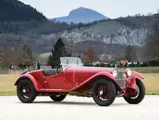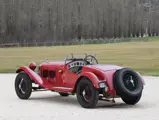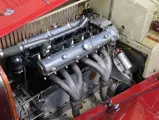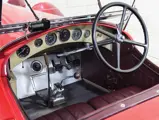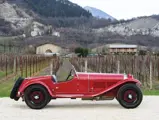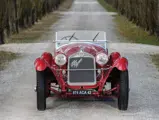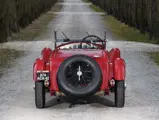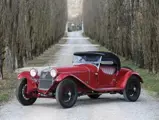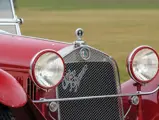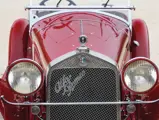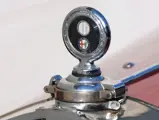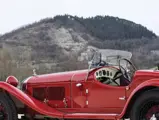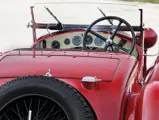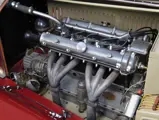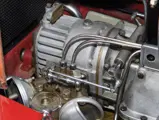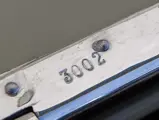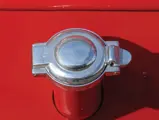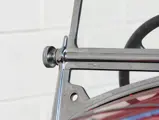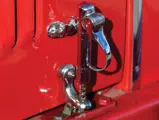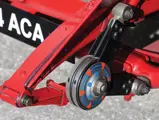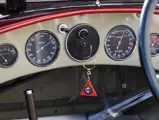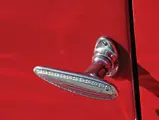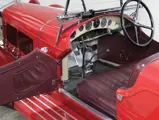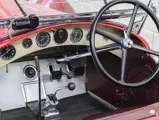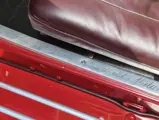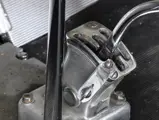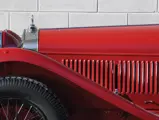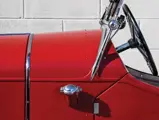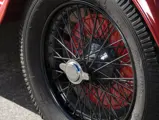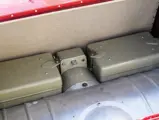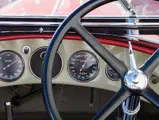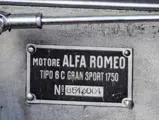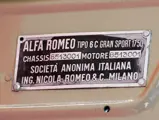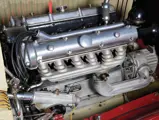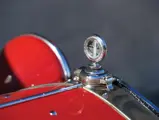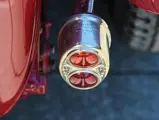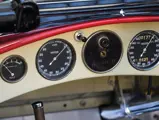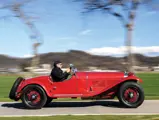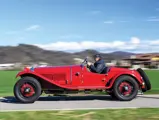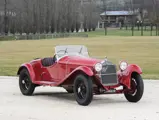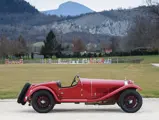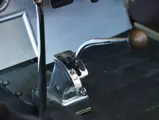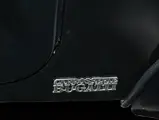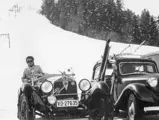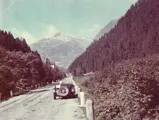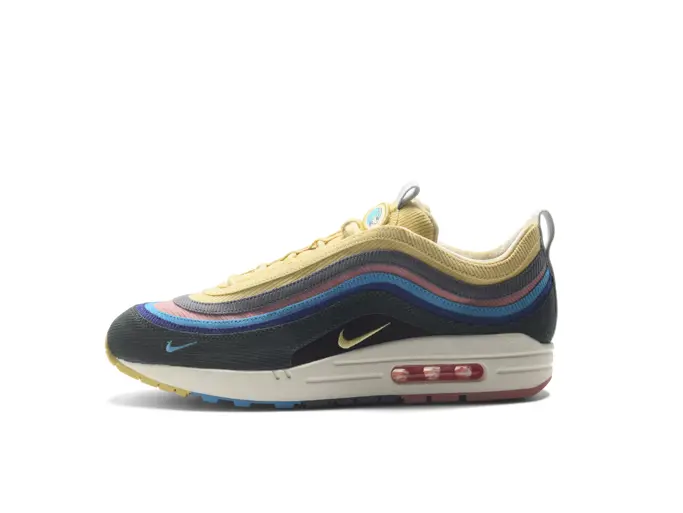Villa Erba 2017
1930 Alfa Romeo 6C 1750 Gran Sport Spider 4th Series by Carrozzeria Sport S.A.
{{lr.item.text}}
€2,200,000 - €2,600,000 EUR | Not Sold
 | Cernobbio, Italy
| Cernobbio, Italy
{{internetCurrentBid}}
{{internetTimeLeft}}

- The first of approximately 102 4th Series examples built
- One of two authentic models clothed with rare coachwork by Carrozzeria Sport S.A.
- Period racing history; well documented chain of ownership
- Fastidiously maintained by two devoted caretakers over the last 64 years
- Comprehensively restored in the 2000s
- Retains its original engine
- Il primo dei circa 102 esemplari di 4° Serie costruiti
- Uno dei soli due esemplari originariamente realizzati con la rara carrozzeria della Carrozzeria Sport S.A.
- Passato sportivo; passaggi di proprietà ben documentati
- Negli ultimi 64 anni sempre mantenuta ad altissimo livello da due attenti proprietari
- Totalmente restaurato negli anni 2000
- Ancora equipaggiato son il suo motore originale
This extremely authentic Alfa Romeo 6C 1750 boasts a number of important distinctions, including a desirable early position in the model’s chassis numbering, period competition history, 64 years of ownership by two fastidious caretakers, and a recent comprehensive refurbishment to concours standards. By virtue of its numerical sequence, chassis 8513001 is the first car built in the fourth series of 6C 1750 Gran Sport Spiders that entered production in 1930.
A lesser-known Milanese coachbuilder called Carrozzeria Sport S.A. clothed the Alfa in an alloy body in the spider body style generally associated with Zagato or Castagna. The handsome race car is believed to have been then sold to Baron Horst Von Waldthausen, a 23-year-old scion of a wealthy industrialist family originally from Essen, Germany. After the Von Waldthausens fled Germany during World War I, the young Baron grew up on the shores of Lake Geneva, Switzerland, where a budding interest in motorsports led him to construct his own private autodrome circuit (much to his neighbours’ chagrin).
In mid-1930, the Baron made a significant financial commitment to motorcycle and grand prix racing at the Meyrin circuit in Switzerland, and around the same time he purchased this 6C 1750, which was officially imported to his adoptive country on 10 June 1930. In 1932, Von Waldthausen formed a racing team, known as the Equipe Villars-Waldthausen, with fellow countryman Julio Villars, and the Baron then entered the Gran Sport at various Swiss Championship hill climbs, starting with the Grand Saconnex in March 1932 (wearing registration number 9221), where it captured 2nd in class.
After Von Waldthausen acquired an Alfa Romeo 8C 2300 for racing in larger-displacement classes, the 6C 1750 was driven by Villars at several events. A 2nd-in-class finish at Klausenpass in Switzerland in early August was followed by a 3rd-place finish at Stelvio in Italy later that month. Villars again finished 2nd in class at Mont Ventoux in France in early September, where Waldthausen simultaneously finished 3rd in the 3-litre class in the 8C, trailing only the legendary Rudi Caracciola and Robert Benoist. The strong results fielded by the team’s Alfa Romeos respectively propelled Waldthausen and Villars to 5th place and 6th place in the 1932 Swiss Championship (sports car class).
Tragedy marked the 1933 season for the Equipe Villars-Waldthausen when the Baron’s 8C blew a tire at speed and flipped during the Grand Prix de Marseille in August, leaving him with insurmountable injuries. By this time, Villars had acquired an 8C Monza of his own, and the 6C 1750 was essentially retired from team use.
Although the racing career of 8513001 appears to have concluded at this point, the car remained in Switzerland for many years, first purchased in May 1949 by Swiss resident Jean Sayare (registration number VD 20441). The spider was sold about 18 months later to Frank Gilroy, who also registered the car with Swiss tags (VD 27635). In January 1953 the Alfa passed to Ernest Mayerat of Switzerland (VD 23172), and he went on to retain possession for over 48 years, preserving the car in optimal original condition. In August 2001, Mr Mayerat sold the Gran Sport to the consignor, a French collector who commissioned a complete restoration by the specialists at Auto Classique Touraine in Veigne, France.
Built in six distinct series through 1933, the 6C 1750 has evolved into one of today’s most collectible interwar Alfa Romeos, encompassing competition pedigree, advanced engineering, and breath-taking exterior aesthetics. Documented with period photographs, restoration photographs, and Swiss registration records back to the early days of the car, this sensational 6C 1750 displays the immaculate benefits of 64 years of dedicated attention by two caretakers. Also believed to retain its factory-installed engine, supercharger and transmission, bonnet, etc. The first-ever 4th Series Gran Sport Spider is now poised for driving enjoyment or presentation at the world’s most discriminating events such as the Mille Miglia, as an exquisite example of one of Alfa Romeo’s most venerated pre-war models.
Questa Alfa Romeo 6C 1750, un esemplare estremamente autentico, vanta una serie di importanti caratteristiche, tra cui una desiderabile posizione molto avanzata nella numerazione del telaio, una storia fatta di competizioni, 64 anni di proprietà da parte di soli due attenti custodi e, un recente restauro a livello da concorso. In virtù della sua sequenza numerica, il telaio 8513001 è la prima macchina costruita nella quarta serie delle 6C 1750 Gran Sport Spider, entrata in produzione nel 1930.
Una carrozzeria milanese meno nota di altre, chiamata Carrozzeria Sport S.A., ha vestito questa Alfa con una carrozzeria aperta, in allumininio, con una forma generalmente associata a carrozzerie come Zagato o Castagna. Si ritiene, poi, che la bella macchina da corsa sia stata venduta al Barone Von Horst Waldthausen, rampollo ventritreenne, di una ricca famiglia di industriali originari di Essen, in Germania. Dopo la fuga di Von Waldthausens dalla Germania, durante la prima guerra mondiale, il giovane Barone è cresciuto sulle rive del Lago di Ginevra, in Svizzera, dove il giovane interesse per le corse automobilistiche lo ha portato a costruire il suo autodromo privato (con grande dispiacere dei suoi vicini).
A metà del 1930, il Barone compie un investimento finanziario significativo nelle corse per moto e vetture grand prix sul circuito Meyrin in Svizzera e, nello stesso periodo acquista questa 6C 1750, che è stata ufficialmente importata nel suo paese d'adozione il 10 giugno 1930. Nel 1932, Von Waldthausen fonda, con il connazionale Julio Villars, una squadra corse conosciuta come l'Equipe Villars-Waldthausen, ed il Barone iscrive la Gran Sport in varie gare in salita valide per il Campionato Svizzero, partendo dalla Grand Saconnex del Marzo 1932 (dove sfoggia il numero di gara 9221) dove giunge secondo di classe.
Dopo l’acquisto da parte di Von Waldthausen di un'Alfa Romeo 8C 2300, per correre nelle classi di cilindrata superiore, la 6C 1750 viene pilotata in diversi eventi da Villars. Finisce, ad inizio Agosto, secondo di classe alla Klausenpass in Svizzera e, nello stesso mese, conclude terzo dii classe allo Stelvio, in Italia. Villars afinisce ancora secondo di classe al Mont Ventoux, in Francia ai primi di settembre, dove, contemporaneamente, Waldthausen arriva terzo nella classe 3 litri della 8C, rimanendo dietro solo ai leggendari Rudi Caracciola e Robert Benoist. Gli importanti risultati ottenuti dalle rispettive Alfa Romeo della scuderia, portano Waldthausen e Villars rispettivamente al 5 ° posto e al 6 ° posto finali nel Campionato Svizzero 1932 (nella classe vetture Sport).
La tragedia segna la stagione 1933 dell’Equipe Villars-Waldthausen quando, durante il Gran Premio di Marsiglia del mese di Agosto, alla 8C del Barone scoppia un pneumatico ad alta velocità e la vettura si capovolge, procurandogli ferite mortali. A questo punto, Villars si era già acquistato una 8C Monza e, la 6C 1750 viene sostanzialmente ritirata dall'uso agonistico.
Sebbene la carriera agonistica della vettura 8513001 sembri concludersi a questo punto, la macchina rimane in Svizzera per ancora molti anni, comprata nel Maggio del 1949 dal residente Svizzero Jean Sayare (e viene targata VD 20441). Circa 18 mesi dopo, la Spider viene rivenduta a Frank Gilroy, che, anche lui, la targa in Svizzera (VD 27635). Nel Gennaio 1953 l'Alfa passa a Ernest Mayerat, sempre in Svizzera (VD 23172), che la terrà ininterrottamente per i futuri 48 anni, conservandola in un ottimo stato di originalità. Nel mese di Agosto del 2001, il Sig. Mayerat vende la Gran Sport al venditore, un collezionista francese che ne commissiona un completo restauro presso gli specialisti della Auto Classique Touraine di Veigne, in Francia.
Costruita in sei ben distinte serie fino a tutto il 1933, la 6C 1750 si è evoluta in una delle Alfa Romeo, costruite tra le due guerre, di più importante valore collezionistico, grazie ai risultati sportivi, all'ingegneria avanzata ed all'estetica mozzafiato della sua linea. Con una storia documentata con fotografie d'epoca e dalle fotografie del restauro e l’elenco completo degli intestatari svizzeri sin dai suoi primi giorni di vita, questa sensazionale 6C 1750 mostra tutti i vantaggi derivanti da 64 anni di dedizione da parte di soli due custodi e mantiene quello che si crede essere il suo motore originale, così come compressore e trasmissione, cofano motore, etc Il primo esemplare Gran Sport Spider della 4 ° Serie è ora pronta a donare piacere di guida o ad essere presentata agli eventi più importanti al mondo, come la Mille Miglia, come squisito esempio di uno dei modelli di Alfa Romeo anteguerra più venerati di sempre.

